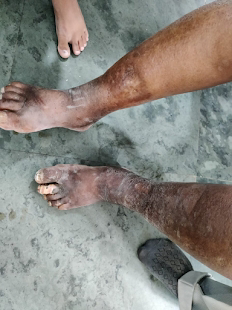1 )What do you think are the factors in this patient that are contributing to his increased severity of symptoms and infection?
Ans: As the patient has previous past history of :
Type 2 Diabetes Mellitus since 7 years
Chronic Kidney Disease since 2 years
Pulmonary Kochs: 7 years back for which he took 6 months of ATT.
Bronchial Asthma since 7 years
Chronic NSAID use: since 1991 for knee pain
Getting admitted to a Hospital in 2019 for B/L Pneumonia.
These above factors are contributing to his severity of symptoms and infection.
2.Can you explain why the D dimer levels are increasing in this patient?
Ans:The liver produces several important proteins involved in the coagulation process, one of which includes fibrinogen. A single fibrinogen molecule is a symmetrical dimer that is made up of three pairs of three different polypeptide chains, which include a, b and g.
Each of the intertwined polypeptide chains that comprise a single fibrinogen molecule is held together by disulfide bonds.
The formation of fibrin begins with the cleaving of the a and b polypeptide chains of the fibrinogen molecule, which is achieved by thrombin. This cleaving event causes the fibrin monomers to spontaneously polymerize, which results in the formation of double-stranded fibrin protofibrils.
To strengthen a normally weak network that exists between the fibrin monomers and the protofibrils, a transglutaminase enzyme known as factor XIIa is activated.
If an injury occurs, the fibrinolytic system will activate to limit the size of the clot. This system begins with the release of the plasminogen activator from the vascular endothelial cells to allow this molecule to bind to the fibrin surface of plasmin.
Several different studies have looked to measure D-dimer levels in hospitalized COVID-19 patients to determine whether this biomarker could be useful in predicting patient outcomes.
3)What were the treatment options taken up with falling oxygen saturation?
Ans:Failure to initiate oxygen therapy can result in serious harm to the patient. The essence of oxygen therapy is to provide oxygen according to target saturation rate, and to monitor the saturation rate to keep it within target range. The target range (SaO2) for a normal adult is 92 – 98%. For patients with COPD, the target SaO2 range is 88 – 92%
Raise the head of the bed
Deep breathing and coughing techniques
If patient is already on supplemental oxygen, ensure equipment is turned on and set at the required flow rate and is connected to an oxygen supply source. If a portable tank is being used, check the oxygen level in the tank. Ensure the connecting oxygen tubing is not kinked, which could obstruct the flow of oxygen. Feel for the flow of oxygen from the exit ports on the oxygen equipment. In hospitals where medical air and oxygen are used, ensure patient is connected to the oxygen flow port.
Applying nasal prongs
Applying nasal prongs
Oxygen is initially started at a low concentration (2 L/min) using nasal prongs. Then the flow is titrated up to maintain oxygen saturation of 92% or greater.
4) Can you think of an appropriate explanation as to why the patient has developed CKD, 2 years ago? (Note: Despite being on anti diabetic medication, there was no regular monitoring of blood sugar levels and hence no way to know for sure if it was being controlled or not)
Ans : Kidney functions therefore need monitoring at least once per year. Pharmacokinetics of antidiabetic drugs may be altered, once the glomerular filtration rate (GFR) is less than 60 ml/min. Risk of hypoglycemia associated with sulfonylurea and glinide therapies is further increased in the presence of renal impairment. Most sulfonylureas must be discontinued once GFR is <60 ml/min. Some glinides may be continued beyond this threshold, in particular repaglinide, which may be used in dialysis patients. In the absence of co morbidities, metformin can be continued at lower doses until a GFR of 45 ml/min, but must be withdrawn in case of dehydration or co-administration of any nephrotoxic drug including dyes for radiological investigations. Glitazones may worsen water and sodium retention in patients with renal impairment. The pharmacokinetics of all DPP-IV inhibitors are altered with impaired renal function. Only linagliptin may be used in advanced kidney disease, but experience is as yet very limited. GLP-1 agonists are contraindicated in moderate to advanced kidney disease. Lastly, insulin therapy, particularly using the new insulin analogues, allows adequate management of hyperglycemia in chronic kidney disease (CKD) patients, with lower risk of hypoglycemia.
10 ) MEDICAL EDUCATION .
This pandemic presents practical and logistical challenges and concerns for patient safety, recognizing that students
may potentially spread the virus when asymptomatic and may acquire the virus in the course of training. This Viewpoint discusses the current status of medical education, describes how COVID-19 may affect preclerkship and clerkship learniing environments, and explores potential implications of COVID-19 for the future of medical education.
The development of entrustable professional activities and competency-based learning with identified milestones for achievement have transformed assessment.This E log experience enhanced many students to profound into their thoughts and helps in gaining clinical knowledge.



Comments
Post a Comment